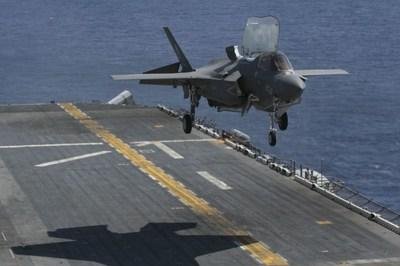A U.S. Marine Corps F-35B Lightning II lands aboard the USS Wasp amphibious assault ship in the Pacific using a joint precision approach and landing system. Photo courtesy of Raytheon
May 23 (UPI) -- Raytheon has been awarded two contracts worth $234.6 million for jets' landing systems on the U.S. Navy's aircraft carriers.
One contract is worth $234.6 million for 23 joint precision approach and landing systems, and another one is for a replacement GPS sensor for the JPALS, the Defense Department announced Wednesday.
The contract for the systems also includes three production and installation engineering development model unit upgrade kits, engineering change proposals and associated data.
Sixty-eight percent of the work will be performed at the company's plant in Fullerton, Calif.; 22 percent in Cedar Rapids, Iowa; and 10 percent in Indianapolis. It is expected to be completed in August 2023.
Naval fiscal 2019 other procurement and fiscal 2019 shipbuilding and conversion funds in the amount of $49.1 million will be obligated at time of award, none of which will expire at the end of the current fiscal year.
In the other contract, the sensor replacement resolves obsolescence driven by part shortages in the digital integrated GOS anti-jam receiver, which is a major subassembly of the unit, according to the Pentagon.
Work is expected to be completed in July 2021, including 59.4 percent in Cedar Rapids and 40.4 percent in Indianapolis.
Naval fiscal 2019 research, development, test and evaluation funds in the full amount will be obligated at time of award, none of which will expire at the end of the current fiscal year.
JPALS guide aircraft onto carriers and amphibious assault ships in all kinds of weather and surface conditions, including rough waters, according to Raytheon. They use an encrypted, jam-proof data link, connecting to software on the aircraft's mission computer and GPS sensors, mast-mounted antennas and rack-mounted shipboard avionics.
"The need for precision landings in harsh environments isn't limited to one military service and one airplane," Matt Gilligan, vice president of Raytheon Navigation, Weather and Services, said. "JPALS can help any fixed or rotary-wing aircraft land in harsh, low-visibility environments."
That includes Air Force aircraft landing on runways.
"If a disaster were to strike in an isolated area with little infrastructure and just a dirt runway, the Air Force, using expeditionary JPALS, could rapidly be on the ground, providing humanitarian relief within an hour of arrival," said retired Air Force Col. JW Watkins, a former fighter pilot now with Raytheon corporate business development. "This capability can help provide emergency relief in the aftermath of a disastrous event, getting people food, water, shelter and medicine to those who need it."















